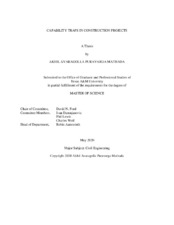| dc.contributor.advisor | Ford, David N | |
| dc.creator | Avaragolla Puravarga Mathada, Akhil | |
| dc.date.accessioned | 2020-12-15T18:35:20Z | |
| dc.date.available | 2022-05-01T07:14:59Z | |
| dc.date.created | 2020-05 | |
| dc.date.issued | 2020-04-24 | |
| dc.date.submitted | May 2020 | |
| dc.identifier.uri | https://hdl.handle.net/1969.1/191524 | |
| dc.description.abstract | Despite having enough resources, most development projects fail to finish before schedule and within budget. We hypothesize that a possible reason for project failure could be a capability trap. Capability on a construction team refers to resources such as workforce, tools, etc. and their combined ability to get work done. Capability traps are vicious cycles which are formed by a short-term firefighting focus, oftentimes at the expense of training or mandatory downtime, which ends up draining the capacity of the system to accomplish work. The phenomenon of capability traps has been studied extensively under the context of continuous operations. However, development projects are discrete time-bound undertakings and are different from continuous operation systems. There exists a crucial knowledge gap regarding the behavior of capability traps in projects which, upon examination, could help us understand the dynamics of projects better.
This research expands the boundaries of traditional project models by identifying and explicitly modeling capability traps. A new archetypical project model was constructed by merging a simplistic project model with an archetypical capability trap model. Upon performing a univariate sensitivity analysis on the archetypical project model and the archetypical capability trap model, it was found that variables related to the allocation of resources had the most influence on continuous operations whereas variables related to the scale of resources/ effort provided had the most influence on projects.
The comparison of analyses highlighted some crucial differences between projects and continuous operations. It was found that excessive investment in capabilities can be detrimental to project progress. The study found that project teams should not sacrifice training/time and effort dedicated towards capability development when facing a strict time constraint as this would land the project in a capability trap and hurt progress in the long run. The best way for project managers to manage capability traps in construction projects would be to increase the total work effort directed towards both capability development and production activities. | en |
| dc.format.mimetype | application/pdf | |
| dc.language.iso | en | |
| dc.subject | Capability | en |
| dc.subject | Capability Trap | en |
| dc.subject | Projects | en |
| dc.subject | Operations | en |
| dc.subject | High-leverage points | en |
| dc.subject | Impact of capability traps | en |
| dc.subject | Comparative Study | en |
| dc.subject | Archtypical model | en |
| dc.title | Capability Traps in Construction Projects | en |
| dc.type | Thesis | en |
| thesis.degree.department | Civil and Environmental Engineering | en |
| thesis.degree.discipline | Civil Engineering | en |
| thesis.degree.grantor | Texas A&M University | en |
| thesis.degree.name | Master of Science | en |
| thesis.degree.level | Masters | en |
| dc.contributor.committeeMember | Damnjanovic, Ivan | |
| dc.contributor.committeeMember | Lewis, Phil | |
| dc.contributor.committeeMember | Wolf, Charles | |
| dc.type.material | text | en |
| dc.date.updated | 2020-12-15T18:35:20Z | |
| local.embargo.terms | 2022-05-01 | |
| local.etdauthor.orcid | 0000-0002-9632-6915 | |


